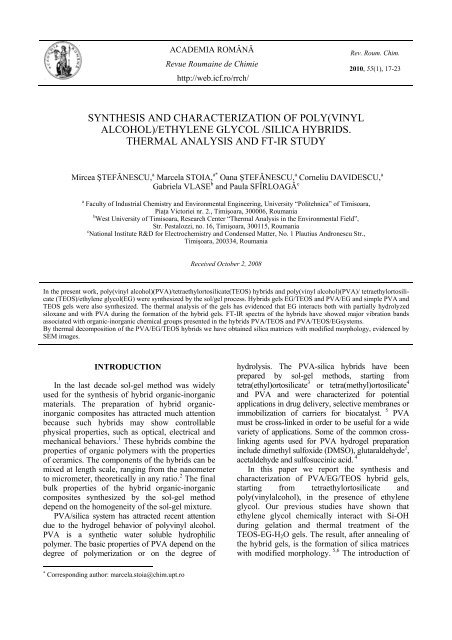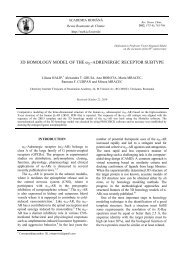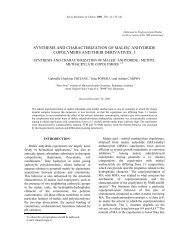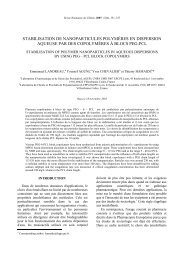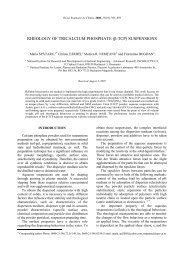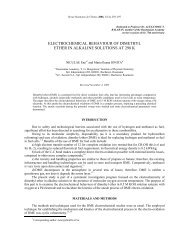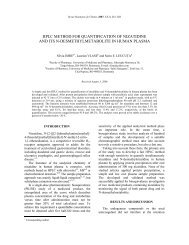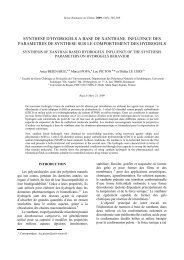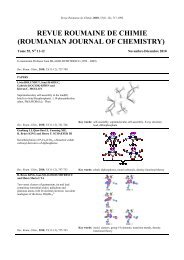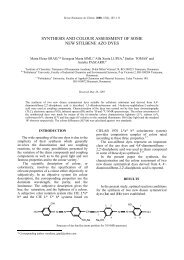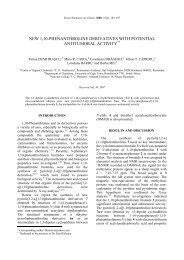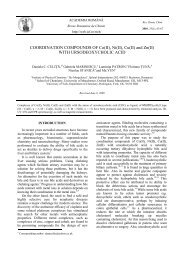synthesis and characterization of poly(vinyl alcohol)/ethylene glycol ...
synthesis and characterization of poly(vinyl alcohol)/ethylene glycol ...
synthesis and characterization of poly(vinyl alcohol)/ethylene glycol ...
Create successful ePaper yourself
Turn your PDF publications into a flip-book with our unique Google optimized e-Paper software.
20 Mircea Ştefănescu et al.The evolution <strong>of</strong> the hybrids TP3 <strong>and</strong> TPE3with the temperatures was also studied by FTIRspectrometry. The spectra <strong>of</strong> the hybrid gels TP<strong>and</strong> TPE thermally treated at 40°C, 80°C, 200°C,300°C <strong>and</strong> 400°C are presented in the fig. 7(TP3)<strong>and</strong> fig. 8 (TPE3).The SEM image <strong>of</strong> the silica matrix obtained byannealing the hybrid gel TPE3 at 600 o C ispresented in fig. 9.Fig. 9 – SEM image <strong>of</strong> the silica matrix obtained by annealing the gel TPE3 at 600 o C.DISCUSSIONThe studies reported in the literature 4,7 havepointed out that acidic catalysis facilitates theformation <strong>of</strong> hybrids TEOS/PVA, due to theextensive H-bonding between the <strong>poly</strong>mer <strong>and</strong>silica network <strong>and</strong> to the crosslinking <strong>of</strong> these two<strong>poly</strong>mers by <strong>poly</strong>condensation reactions, enablingsystem homogeneity.In our previous studies 5,6 we showed that thepresence <strong>of</strong> <strong>ethylene</strong> <strong>glycol</strong> in the TEOS-H2O systemleads to homogeneous hybrid gels due to thechemical interaction between EG <strong>and</strong> silica. Thepresence <strong>of</strong> EG facilitates the formation (after asuitable thermal treatment) <strong>of</strong> silica matrices withmodified morphology (higher specific surface areas).We initiated the present study <strong>of</strong> TEOS-PVA-EG gels in order to establish the possibleinteractions between EG <strong>and</strong> PVA that mightinfluence the formation <strong>of</strong> the hybrid gelsTEOS/PVA/EG, for later applications in thin silicafilms with high specific surface area.Fig. 1 presents the FT-IR spectra <strong>of</strong> PVAhydrogel (P), silica gel (T) <strong>and</strong> TEOS/PVA hybridgels (TP2, TP4) obtained at room temperature.Spectrum (1) <strong>of</strong> the PVA hydrogel (P) presentsb<strong>and</strong>s characteristic to free (3560 cm -1 ) <strong>and</strong>hydrogen bonded (3157 cm -1 ) -OH groups 2 , to CH 2<strong>and</strong> CH groups (2933 cm -1 ,2860 cm -1 , 1346 cm -1 ) 8,9<strong>and</strong> to C – O stretching <strong>of</strong> free <strong>and</strong> condensed C-OH groups (1440 cm -1 ,1099 cm -1 <strong>and</strong> 840 cm -1 ). 2,10It also presents b<strong>and</strong>s characteristic to terminal<strong>vinyl</strong> groups 5 (1660 cm -1 ) <strong>and</strong> non-hydrolyzed<strong>vinyl</strong> acetate groups (b<strong>and</strong> at 1720 cm -1 ) 8 fromPVA.Spectrum (2) <strong>of</strong> silica gel (T) displays b<strong>and</strong>scharacteristic to H-bonded –OH (Si-OH <strong>and</strong> H-OH) at 3430 cm -1 <strong>and</strong> 1640 cm -1 <strong>and</strong> b<strong>and</strong>scharacteristic to the Si – O – Si bonds 10 at 1074cm -1 , 798 cm -1 <strong>and</strong> 462 cm -1 . The b<strong>and</strong> at 952 cm -1is due to the Si – OH stretching vibrations. 1Spectra (3) <strong>and</strong> (4) <strong>of</strong> the hybrid gelTEOS/PVA: TP2 (spectrum 3) <strong>and</strong> TP4 (spectrum4) display b<strong>and</strong>s characteristic both to silica matrix(455, 567 cm -1 798, 960, 1072, 1649) <strong>and</strong> to PVA(3200-3400 cm -1 , 2945 cm -1 , 2890 cm -1 , 1556 cm -1 ,1438 cm -1 , 1130 cm -1 ), partially overlapped.Comparison <strong>of</strong> the IR spectra obtained forTEOS/PVA gels with different contents <strong>of</strong> PVAshowed that for initial molar ratio PVA(expressedin mole <strong>of</strong> [C-C] units)/TEOS lower than 1.33 (e.g.TP2 (spectrum 3)), a strong b<strong>and</strong> is present at~3600 cm -1 , due to the unassociated -OH groups(from PVA). In these cases another b<strong>and</strong> appears at
22 Mircea Ştefănescu et al.thermal degradation. The residue at 600°C is white,so we have no residual carbon left in this case.The evolution <strong>of</strong> the hybrid gels with thetemperature was studied also by FT-IRspectrometry. Fig. 7 <strong>and</strong> Fig. 8 present the FT-IRspectra <strong>of</strong> the gels TP3 (fig.7) <strong>and</strong> TPE3 (fig.8)thermally treated at 40, 80, 200, 300 <strong>and</strong> 400°C.In case <strong>of</strong> the gel TP3 (fig. 7) modifications <strong>of</strong>FTIR spectra with the temperature <strong>of</strong> the thermaltreatment occur first in the 3000-4000 cm -1 range.Thus, by heating the gel at 80°C the b<strong>and</strong>characteristic to non-bonded C-OH groups (3600cm -1 , spectrum 1) significantly diminishes, whilethe b<strong>and</strong> characteristic to H-bounded –OH groupsbecomes a broad b<strong>and</strong> in the range 3000-3500 cm -1(spectrum 2). Also, starting with 80°C (spectrum2) but more obvious at 200°C (spectrum 3), newb<strong>and</strong>s appear at 1700 cm -1 <strong>and</strong> 1570 cm -1 , due tothe double bonds (C=C) generated by dehydration<strong>of</strong> unbounded C-OH groups <strong>of</strong> PVA <strong>and</strong> possibleto some C=O bonds 15 formed during PVAdecomposition. These b<strong>and</strong>s together with theb<strong>and</strong>s characteristic to C-H bonds (1300-1400 cm -1 ,2800-3000 cm -1 ) are also present in the spectrum(4) <strong>of</strong> the gel treated at 300°C, but become weak at400°C (spectrum 5).In case <strong>of</strong> the gel TPE3 (TEOS/PVA/EG), theevolution <strong>of</strong> FTIR spectra with the temperature <strong>of</strong>the thermal treatment is different (fig.8). Thus, inthe region 3000-3500 cm -1 no differences appears,but a decrease in intensity <strong>of</strong> the b<strong>and</strong> from 3400cm -1 at temperature higher than 200°C (spectra 4<strong>and</strong> 5). Spectra (1) <strong>and</strong> (2) present the b<strong>and</strong> from880 cm -1 characteristic to EG, but at 200°C(spectrum 3) the b<strong>and</strong> characteristic to EG becomeless visible, due to its volatilization from thematrices pores. Only the EG bounded with Si-OHor C-OH groups remains in the gel above 200°C.The b<strong>and</strong>s characteristic to C-H bonds (1300-1400cm -1 , 2800-3000 cm -1 ) are significantly weakerafter thermal treatment at 400°C.A significant aspect in case <strong>of</strong> the TPE3 gel isthe higher intensity <strong>of</strong> the b<strong>and</strong>s characteristic tosilica matrix (especially 800 cm -1 <strong>and</strong> 460 cm -1 )starting from 200°C which reflects a morehomogenous organic – inorganic hybrid in thiscase. A possible explanation is that EG interacts(by condensation) with both C-OH <strong>and</strong> Si-OHgroups, playing the role <strong>of</strong> a cross-linking agent.The SEM image <strong>of</strong> the silica matrix obtainedafter annealing <strong>of</strong> the gel TPE3 at 600°C ispresented in fig.9. The SEM image <strong>of</strong> this sampleevidenced the formation <strong>of</strong> a silica matrix with ahomogenous structure <strong>and</strong> network-like porousstructures resulted by thermal decomposition <strong>of</strong> theorganic component <strong>of</strong> the initial hybrid gel.EXPERIMENTALTetraethylortosilicate Si(OC 2 H 5 ) 4 (TEOS, > 99.5%),<strong>ethylene</strong> <strong>glycol</strong> (OH-CH 2 -CH 2 -OH) (> 99.5%) <strong>and</strong> PVA withan average molecular weight <strong>of</strong> 75 000 g/mol (hydrolysisdegree >98%) were supplied by Merck.5% (wt.%) PVA solution was prepared by dissolving PVAin distilled water <strong>and</strong> vigorously stirred at 60°C, using amagnetic stirrer. After total dissolution <strong>of</strong> the <strong>poly</strong>mer HNO 3was added to the solution. The 5% PVA solution was used for<strong>synthesis</strong> <strong>of</strong> PVA, PVA-EG hydrogels <strong>and</strong> <strong>of</strong> PVA/TEOS,PVA/EG/TEOS hybrids. The hybrids have been prepared byadding the corresponding mass <strong>of</strong> the PVA solution to theTEOS-H 2 O-EtOH (for the PVA/TEOS hybrids) or to theTEOS-H 2 O-EG-EtOH solution (for the PVA/EG/TEOShybrids) under vigorous stirring with a magnetic stirrer. Themolar ratio <strong>of</strong> the reactants for each sample are presented intable 1.Table 1Molar ratio <strong>of</strong> the starting materials for the gels <strong>synthesis</strong>Quantity/moleSample TEOS EGPVAH 2 OPVA [C-C] unitMolar ratioTEOS:EG:PVA([C-C]):H 2 OP - - 1.33.10 -5 0.0227 1.11 0:0:1:49PE - 0.0166 1.33.10 -5 0.0227 1.11 0:3:4:195TP1 0.0166 - 3.33.10 -6 0.00568 1.11 3:0:1:195TP2 0.0166 - 6.66.10 -6 0.0114 1.11 3:0:2:195TP3 0.0166 - 9.99.10 -6 0.0170 1.11 3:0:3:195TP4 0.0166 - 1.33.10 -5 0.0227 1.11 3:0:4:195TPE1 0.0166 0.0166 3.33.10 -6 0.00568 1.11 3:3:1:195TPE2 0.0166 0.0166 6.66.10 -6 0.0114 1.11 3:3:2:195TPE3 0.0166 0.0166 9.99.10 -6 0.0170 1.11 3:3:3:195TPE4 0.0166 0.0166 1.33.10 -5 0.0227 1.11 3:3:4:195TE 0.0166 0.0166 - - 1.11 3:3:0:195T 0.0166 - - - 0.11 3:0:0:19.5
Poly(<strong>vinyl</strong> <strong>alcohol</strong>)/<strong>ethylene</strong> <strong>glycol</strong>/silica hybrids 23The as obtained sols, have been left to gel at roomtemperature in covered recipients. After gelation, the obtainedhybrids have been characterized by thermal analysis, FT-IRspectrometry <strong>and</strong> SEM microscopy.Experimental techniquesThe synthesized gels were characterized by thermalanalysis using a 1500 D MOM Budapest derivatograph <strong>and</strong> aDiamond Perkin Elmer Termobalance. The experiments havebeen done in air, in the temperature range 20-800 0 C, with aheating rate <strong>of</strong> 10 0 C· min -1 , using as reference α-Al 2 O 3 . FT-IRspectrometry was performed with a Schimadzu Prestige-21FT-IR spectrometer, in KBr pellets, in the range 400- 4000cm -1 .SEM images have been recorded with an Inspect-Smicroscope.CONCLUSIONSThe presented study has evidenced that theintroduction <strong>of</strong> PVA in TEOS/EG system leads tohybrid gels, more homogenous compared withTEOS/PVA hybrids. The interactions betweenEG–TEOS <strong>and</strong> EG–PVA have been evidenced bythermal analysis <strong>and</strong> FT-IR spectrometry.The influences <strong>of</strong> the EG on the formation <strong>of</strong>the organic-inorganic hybrids <strong>and</strong> <strong>of</strong> the final silicamatrix, suggests that he may play the role <strong>of</strong> acrosslinking agent.REFERENCES1. D.S. Kim, H.B.Park, J.W. Rhim <strong>and</strong> Y.M. Lee, J. Membr.Sci., 2004, 240, 37-48.2. E.F. dos Reis, F.S. Campos, A.P.Lage, R.C. Leite, L.G.Heneine, W.L. Vasconcelos, Z.I.P. Lobato <strong>and</strong> H.S.Mansur, Mat. Res., 2006, 9, 158-191.3. Kim, Y.liu, H. Chen, L. Zhang <strong>and</strong> X. Yao, J.Sol-Gel Sci.Techn., 2002, 25, 95-101.4. M. Cajlakovic, A. Lobnik T. <strong>and</strong> Werner, Anal. Chim.Acta, 2002, 455, 207-213.5. M. Ştefănescu, M.Stoia <strong>and</strong> O. Ştefănescu, J. Sol-Gel Sci.Techn., 2007, 41, 71-78.6. M. Ştefănescu, M. Stoia, O.Ştefănescu, A.Popa, M.Simon<strong>and</strong> C. Ionescu, J.Therm.Anal.Cal., 2007, 88, 19-26.7. T. Kotoky <strong>and</strong> S.K. Dolui, J. Sol-Gel Sci. Technol., 2004,29, 107-114.8. J.M. Gohil <strong>and</strong> A. Bhattarcharya, P. Ray, J. Polymer Res.,2006, 13, 161-169.9. N.V. Petrova, A.M. Evtushenko, I.P. Chikhacheva, V.P.Zubov,I.V. <strong>and</strong> Kubrakova, Russ. J. Appl. Chem., 2005,78, 1158-1161.10. B. Samuneva, P. Djambaski, E. Kashchieva, G. Chernev,L. Kabaivanova, E. Emanuilova, I.M. M. Salvado,M.H.V. Fern<strong>and</strong>ez, A. <strong>and</strong> Wu, J. Non-cryst. Solids,2008, 354, 733-740.11. K.Pal, A.K. Banthia <strong>and</strong> D.K. Majumdar, TrendsBiomater. Artif. Organs, 2006, 20, 59-67.12. L.Y.Ye, Q.L.Liu, Q.G. Zhang, A.M. Zhu <strong>and</strong> G.B. Zhou,J. Appl. Polym. Sci., 2007, 105, 3640-3648.13. R.F.S. Lenza <strong>and</strong> W.L. Vasconcelos, J. Non-Cryst.Solids,2003, 330, 216.14. G. Andrade, E.F. Barbosa-Stancioli, A.A.P. Mansur,W.L. Vasconcelos <strong>and</strong> H.S. Mansur, Biomed. Mater.,2006, 1, 221-234.15. B.J. Holl<strong>and</strong> <strong>and</strong> J.N. Hay, Polymer, 2001, 42, 6775-6783.16. P.S. Thomas, J.P. Guerbois, G.F. Russel <strong>and</strong> B.J. Briscoe,J. Therm. Anal. Cal., 2001, 64, 501-508.17. P. Budrugeac, J. Therm. Anal. Cal., 2008, 92, 291-296.18. D.L. Gardner <strong>and</strong> I.C. Mc.Neill, J. Therm. Anal. Cal.,1969, 1, 389-402.
18 Mircea Ştefănescu et al.


